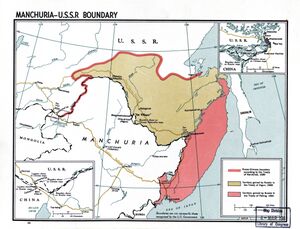معاهدة آيغون
| معاهدة آيغون | |||||||
|---|---|---|---|---|---|---|---|
 التغيرات في حدود روسيا-الصين في القرن 19. الأراضي المتنازَل عنها لروسيا في معاهدة آيغون تظهر باللون الأصفر. | |||||||
| Chinese name | |||||||
| الصينية التقليدية | 璦琿條約 | ||||||
| الحروف المبسطة | 瑷珲条约 | ||||||
| |||||||
| Russian name | |||||||
| Russian | Айгунский договор | ||||||
| Romanization | Aygunskiy dogovor | ||||||
معاهدة آيگون/آيغون Treaty of Aigun كانت معاهدة في 1858 بين Russian Empire and the Qing dynasty that established much of الحدود الحديثة بين الشرق الأقصى الروسي والصين by ceding much of Manchuria (the ancestral homeland of the Manchu people), now known as Northeast China.[1] Negotiations began after China was threatened with war on a second front by Governor-General of the Far East Nikolay Muraviev when China was suppressing the Taiping Rebellion.[2] It reversed the Treaty of Nerchinsk (1689) by transferring the land between the Stanovoy Range and the Amur River from the Qing Dynasty to the Russian Empire. Russia received over 600،000 متر كيلومربع (231،660 sq mi) of what became known as Russian Manchuria.[3][2]
خلفية
Since the reign of Catherine the Great (1762 – 1796), Russia had desired to become a naval power in the Pacific. It gradually achieved its goals by annexing the Kamchatka Peninsula and establishing the naval outpost of Petropavlovsk-Kamchatsky in 1740, naval outposts in Russian America and near the Amur watershed, encouraging Russians to go there and settle, and slowly developing a strong military presence in the Amur region.
From 1850 to 1864, when China was heavily involved in suppressing the Taiping Rebellion, and Governor-General of the Far East Nikolay Muraviev camped tens of thousands of troops on the borders of Mongolia and Manchuria, preparing to make legal Russian de facto control over the Amur from past settlement.[3] Muraviev seized the opportunity when it was clear that China was losing the Second Opium War, and threatened China with a war on a second front.[2] The Qing Dynasty agreed to enter negotiations with Russia.[3]
التوقيع
The Russian representative Muraviev and the Qing representative Yishan, both military governors of the area, signed the treaty on May 28, 1858، في بلدة آيغون.[2]
الآثار
The resulting treaty established a border between the Russian and Chinese Empires along the Amur River. (Chinese and Manchu residents of the Sixty-Four Villages East of the River would be allowed to remain, under the jurisdiction of Manchu government.) The Amur, Sungari, and Ussuri rivers were to be open exclusively to both Chinese and Russian ships. The territory bounded on the west by the Ussuri, on the north by the Amur, and on the east and south by the Sea of Japan was to be jointly administered by Russia and China—a "condominium" arrangement similar to that which the British and Americans had agreed upon for the Oregon Territory in the Treaty of 1818.[3] (Russia gained sole control of this land two years later.)[4]
- The inhabitants along the Amur, Sungari, and Ussuri rivers were to be allowed to trade with each other.
- The Russians would retain Russian and Manchu copies of the text, and the Chinese would retain Manchu and Mongolian copies of the text.
- All restrictions on trade to be lifted along the border.
كيف رأتها الصين
In China, especially after the rise of Chinese nationalism in the 1920s,[بحاجة لمصدر] the treaty has been denounced as an unequal treaty.[5]
انظر أيضاً
- معاهدة پكين
- ضم آمور
- منشوريا الروسية
- نزاعات الحدود الروسية الصينية
- المعاهدات غير المتكافئة
- الإمبريالية الغربية في آسيا
المراجع
- ^ "Russia and China end 300 year old border dispute". BBC News. 10 November 1997. Retrieved 14 August 2010.
- ^ أ ب ت ث Paine, SCM (2003). The Sino-Japanese War of 1894–1895: perceptions, power, and primacy. Cambridge University Press. ISBN 978-0-521-81714-1.[dead link]
- ^ أ ب ت ث Tzhou, Byron N (1990). China and international law: the boundary disputes. Greenwood Publishing Group. p. 47. ISBN 978-0-275-93462-0.
- ^ Bissinger, Sally (26 June 1969). "The Sino-Soviet Border Talks". Radio Liberty research bulletin. Archived from the original on 26 February 2012. Retrieved 14 August 2010.
- ^ "Treaty of Aigun". Encyclopædia Britannica. Retrieved 12 May 2021.
- Articles with dead external links from May 2023
- Short description is different from Wikidata
- Articles containing صينية-language text
- Articles containing روسية-language text
- مقالات ذات عبارات بحاجة لمصادر
- معاهدات غير متكافئة
- تاريخ منشوريا
- القرن 19 في الإمبراطورية الروسية
- معاهدات تضمنت تغييرات إقليمية
- 1858 في الصين
- معاهدات روسيا-الصين
- معاهدات حدودية
- حدود روسيا-الصين
- معاهدات 1858
- معاهدات الامبراطورية الروسية
- معاهدات أسرة تشينگ
- أحداث مايو 1858
- علاقات الإمبراطورية الروسية-الصين


